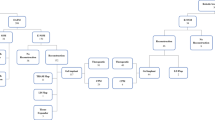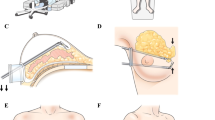Abstract
Background
Minimally invasive (robotic or laparoscopic-assisted) nipple-sparing mastectomy combined with prosthesis breast reconstruction (NSM–PBR) is associated with smaller scars and greater patient satisfaction. However, the oncological safety of minimally invasive NSM–PBR remains controversial.
Patients and Methods
This was a retrospective study of patients with breast cancer who underwent breast reconstruction between 1 January 2006 and 20 February 2021. Demographic and clinicopathological characteristics, operation information, postoperative complications, and survival outcomes were analyzed.
Results
In all, 292 patients underwent minimally invasive NSM–PBR and 205 underwent open NSM–PBR for breast cancer. In the minimally invasive NSM–PBR group, 268 (91.8%) patients underwent laparoscopy and 24 (8.2%) patients underwent robot-assisted NSM–PBR. Mean operation time in the minimally invasive NSM–PBR group was significantly longer than that in the open NSM–PBR group (P = 0.023). Mean intraoperative blood loss was significantly less in the minimally invasive NSM–PBR group (P < 0.05). There was no significant between-group difference in total complications. Similarly, there were no significant between-group differences in overall survival, recurrence-free survival, and local recurrence rate (P = 0.450, P = 0.613, and P = 0.679, respectively).
Conclusions
The complication, recurrence, and mortality rates in minimally invasive NSM–PBR group were comparable to those in open NSM–PBR group. Our preliminary results are encouraging and suggest that minimally invasive NSM–PBR affords good cosmetic results and its oncological safety is comparable to that of open surgery.


Similar content being viewed by others
References
Lin W, Yang Y, Zhong W, et al. The effect of low and high vacuum drainage on the postoperative drainage of breast cancer: insights from a prospective, non-inferiority, randomized clinical trial. Cancer Manag Res. 2020;12:12487–96.
Gui Y, Liu X, Chen X, et al. A network meta-analysis of surgical treatment in patients with early breast cancer. J Natl Cancer Inst. 2019;111(9):903–15.
O’Connell RL, Rattay T, Dave RV, et al. The impact of immediate breast reconstruction on the time to delivery of adjuvant therapy: the iBRA-2 study. Br J Cancer. 2019;120(9):883–95.
Huang CJ, Hou MF, Lin SD, et al. Comparison of local recurrence and distant metastases between breast cancer patients after postmastectomy radiotherapy with and without immediate TRAM flap reconstruction. Plast Reconstr Surg. 2006;118(5):1079–86.
Shen Z, Sun J, Yu Y, et al. Oncological safety and complication risks of mastectomy with or without breast reconstruction: a Bayesian analysis. J Plast Reconstr Aesthet Surg. Sep 20 2020.
Ito K, Kanai T, Gomi K, et al. Endoscopic-assisted skin-sparing mastectomy combined with sentinel node biopsy. ANZ J Surg. 2008;78(10):894–8.
Ozaki S, Ohara M. Endoscopy-assisted breast-conserving surgery for breast cancer patients. Gland Surg. 2014;3(2):94–108.
Toesca A, Invento A, Massari G, et al. Update on the feasibility and progress on robotic breast surgery. Ann Surg Oncol. 2019;26(10):3046–51.
Toesca A, Sangalli C, Maisonneuve P, et al. A Randomized trial of robotic mastectomy versus open surgery in women with breast cancer or BRCA mutation. Ann Surg. 2021. https://doi.org/10.1097/SLA.0000000000004969.
Ramirez PT, Frumovitz M, Pareja R, et al. Minimally invasive versus abdominal radical hysterectomy for cervical cancer. N Engl J Med. 2018;379(20):1895–904.
Jiang J, Yang XH, Fan LJ, Zhang Y, Zhang F, Zhou Y. Application of endoscopy-assistant operation in surgical treatment of breast diseases. Zhonghua Yi Xue Za Zhi. 2005;85(3):181–3.
Du J, Mo H, Fan L, Jiang J. Robot-assisted internal mammary lymph chain excision for breast cancer: a case report. Medicine. 2017;96(35):e7894.
Yarnold J. Early and locally advanced breast cancer: diagnosis and treatment National Institute for Health and Clinical Excellence guideline 2009. Clin Oncol. 2009;21(3):159–60.
Yang JD, Lee J, Lee JS, Kim EK, Park CS, Park HY. Aesthetic scar-less mastectomy and breast reconstruction. J Breast Cancer. 2021;24(1):22–33.
Lai HW, Chen ST, Chen DR, et al. Current trends in and indications for endoscopy-assisted breast surgery for breast cancer: results from a six-year study conducted by the Taiwan Endoscopic Breast Surgery Cooperative Group. PloS One. 2016;11(3):e0150310.
Davila AA, Mioton LM, Chow G, et al. Immediate two-stage tissue expander breast reconstruction compared with one-stage permanent implant breast reconstruction: a multi-institutional comparison of short-term complications. J Plast Surg Hand Surg. 2013;47(5):344–9.
Wattoo G, Nayak S, Khan S, et al. Long-term outcomes of latissimus dorsi flap breast reconstructions: a single-centre observational cohort study with up to 12 years of follow up. J Plast Reconstr Aesthet Surg. 2021;74(9):2202–9.
Lee D, Jung BK, Roh TS, Kim YS. Ultrasonic dissection versus electrocautery for immediate prosthetic breast reconstruction. Arch Plast Surg. 2020;47(1):20–5.
Kitamura K, Ishida M, Inoue H, Kinoshita J, Hashizume M, Sugimachi K. Early results of an endoscope-assisted subcutaneous mastectomy and reconstruction for breast cancer. Surgery. 2002;131(1 Suppl):S324–9.
Lai HW, Chen ST, Mok CW, et al. Robotic versus conventional nipple sparing mastectomy and immediate gel implant breast reconstruction in the management of breast cancer—a case control comparison study with analysis of clinical outcome, medical cost, and patient-reported cosmetic results. J Plast Reconstr Aesthet Surg. 2020;73(8):1514–25.
Lai HW, Wang CC, Lai YC, et al. The learning curve of robotic nipple sparing mastectomy for breast cancer: an analysis of consecutive 39 procedures with cumulative sum plot. Eur J Surg Oncol. 2019;45(2):125–33.
Funding
This work was supported by the Chongqing Technology Innovation and Application Development Project (no. cstc2019jscx-msxmX0191) and grants from the National Key Research and Development Program of China (no. 2018YFC1707503).
Author information
Authors and Affiliations
Corresponding author
Ethics declarations
Disclosure
There are no conflicts of interest for this study.
Additional information
Publisher's Note
Springer Nature remains neutral with regard to jurisdictional claims in published maps and institutional affiliations.
Rights and permissions
About this article
Cite this article
Gui, Y., Chen, Q., Li, S. et al. Safety and Feasibility of Minimally Invasive (Laparoscopic/Robotic-Assisted) Nipple-Sparing Mastectomy Combined with Prosthesis Breast Reconstruction in Breast Cancer: A Single-Center Retrospective Study. Ann Surg Oncol 29, 4057–4065 (2022). https://doi.org/10.1245/s10434-022-11420-8
Received:
Accepted:
Published:
Issue Date:
DOI: https://doi.org/10.1245/s10434-022-11420-8




